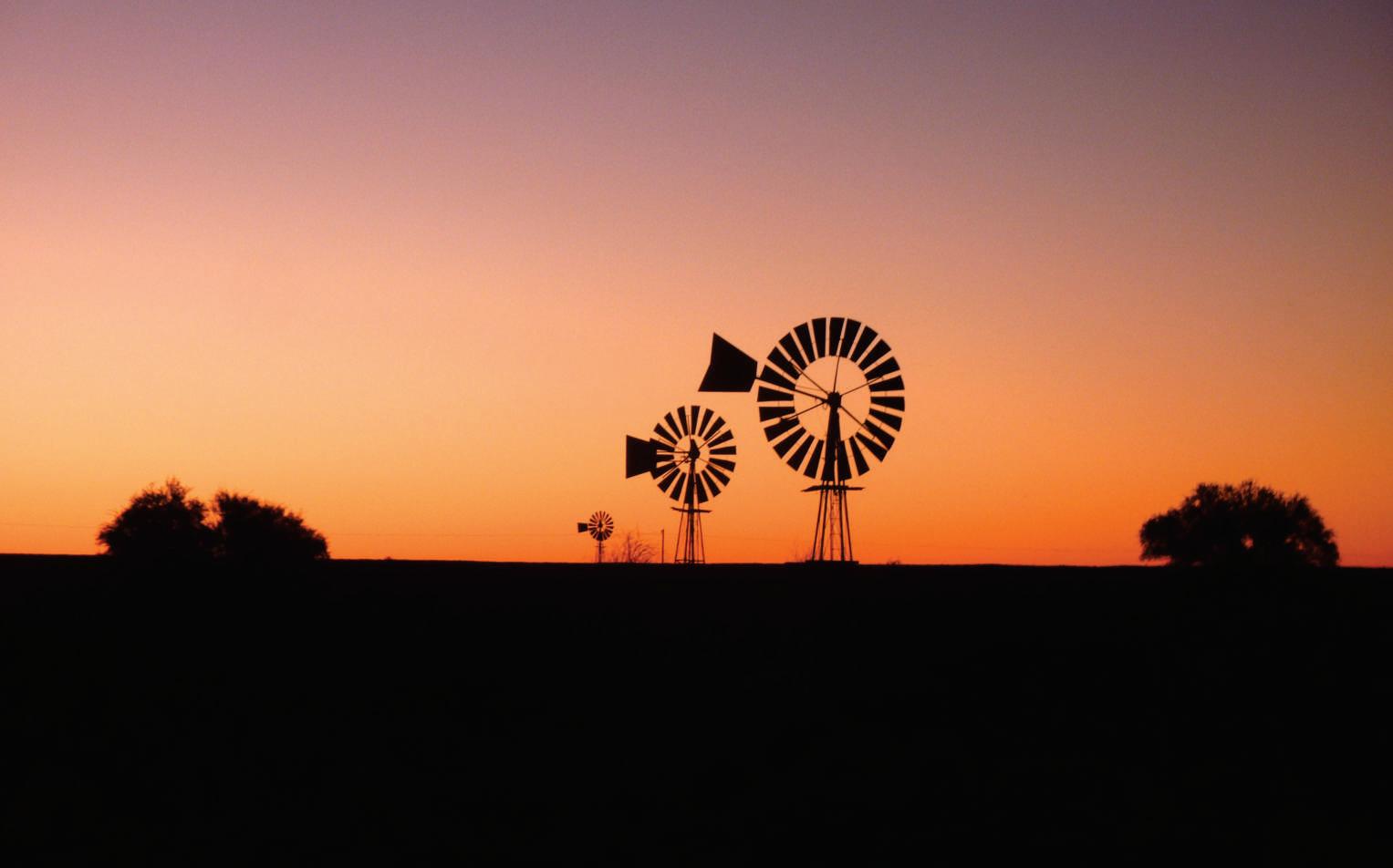
12 minute read
Chemical Evidence For Milk, Meat, And Marine Resource Processing In Later Stone Age Pots From Namaqualand, South Africa
The subsistence practices of Later StoneAge (LSA) foragers and herders living in Namaqualand SouthAfrica are often difficult to differentiate based on their archaeological signatures but characterizing their dietary choices is vital to understand the economic importance of domesticates. However, ethnohistoric accounts have provided information on the cooking/boiling of marine mammal fat, mutton, plants, and milk by early herders and foragers across the Western Cape.To further investigate these reports, we use lipid residue analysis to characterize 106 potsherds from four open-air LSAsites, spanning in time from the early first millennium to the late second millenniumAD.Two sites (SK2005/057A, SK2006/026) are located on the Atlantic coast whereas sites Jakkalsberg K and Jakkalsberg M are located further inland on the southern bank of the Orange River. Notably, at the coastal sites, the presence of marine biomarkers suggests the intensive and/or specialized processing of marine products in many vessels.The dominance of ruminant carcass products at inland sites and probable sheep remains confirms the importance of stockkeeping. Furthermore, and in good agreement with ethnohistoric accounts for its use, our results provide the first direct chemical evidence for the use of dairy products in LSA western SouthAfrica.
Introduction
Advertisement
During the 15th Century, European ships rounding the Cape of Good Hope encountered pastoralists with large herds of livestock1,2,3,4 at the newly established provisioning station at Cape Town.Yet these sheep and cattle remain archaeologically enigmatic5, making it difficult to study Indigenous herd management strategies and human-animal relationships. Questions as to the introduction of domesticated animals to southernAfrica, the subsequent spread of herding and the beginnings of dairying practices, also remain unresolved.
Looking to the northwest corner of SouthAfrica, the Namaqualand coastal desert, extending along the west coast over 1000 km, is the optimal location for unequivocal herder sites (indicated by the presence of domestic animal bone) as the homeland of Nama pastoralists. Spoegrivier Cave in Namaqualand is the location of the oldest directly dated (AMS 14C) sheep bone (confirmed through palaeoproteomics6,7) in SouthAfrica at 2105 ± 65 BP (OxA-3862), together with a horn core from site KN2005/0041 directly dated to 1625 ± 25 BP (OxA-22933) and identified through aDNAas Bos taurus8, suggesting the early presence of herders in the region. However, although there are many (c. 1500) Late StoneAge (LSA: 40 kya to historic times) open-air, single occupation sites in the region (the vast majority being shell middens and scatters along the coastal plain)9, to date, only ~ 15 have definitively been identified as herder sites, based on the presence of domesticated animal remains10.
One of the difficulties lies in distinguishing between forager and herder sites as both have similar material cultural signatures after 2000 BP: stone tools, pottery, wild fauna, and ostrich eggshell beads11.This means that LSAsites with domesticate remains are simply labelled herder and those without, forager. In western SouthAfrica, this oversimplistic dichotomy can easily overlook the fluidity of subsistence practices (e.g., ‘hunterherders’12,13,14,15) during the LSAand how groups may have incorporated available resources into their diet. Further complicating matters is that faunal assemblages within the region are often highly fragmentary, making attributions between sheep and similar-sized local wild bovids, such as springbok and grey duiker, somewhat problematic7,16,17,18.This is particularly relevant as the timing of the introduction of domesticated sheep to southern Africa is still not fully understood.
Ethnohistoric accounts of the use of pottery in western South Africa
Cape Ceramics found along the west coast of SouthAfrica take three broad forms, lugged, spouted, and bowl-shaped. Lugged pots, commonly associated with herders, have pointed bases, flared shoulders, constricted necks and two opposed suspension lugs12,13,19. Spouted pots are generally indistinguishable from lugged pottery below the shoulder but have an obliquely angled spout13. Bowls are small hemispherical vessels with thick, crudely finished walls and round bases that lack decoration, bosses, or lugs19 and are commonly associated with foragers. However, whilst most ethnohistoric accounts20, as cited in 21, illustrations22 and archaeological23 evidence suggest that pottery typology did follow the generalized “herderforager” dichotomy, there are also accounts of foragers using lugged pottery and herders using open-mouthed bowls. For example, two historical illustrations attributed to S. Daniell21 show an unmistakeable “herder” lugged vessel standing in a forager camp and the other an unmistakable “forager” bowl hanging from a forked stick strapped to an ox ready for transport21 (see also Stewart24 for an archaeological example of this fluidity in pottery use).
Although relatively scarce, ethnohistoric accounts have provided some information on what foodstuffs early herders and foragers processed in their ceramic pots, namely the cooking/boiling of marine mammal fat, mutton, plants, and milk25. For example, in 1654, Jan van Riebeek (of the Dutch East India Company) noted that he observed Khoekhoe (nonBantu speaking Indigenous nomadic pastoralists) using pottery to render whale blubber26. Certainly, postcontact herders were known to have used marine mammal grease as an important component of body adornment26 and as a supplement to their lean diet27.
In the course of his travels through the Western Cape in the late 1700’s, Le Vaillant noted that pottery appeared to be used for the purpose of melting animal fat into grease and discusses Khoekhoen guides breaking up elephant bones and rendering their grease in tea kettles28. Laidler10, during his travels through Namaqualand in the early 1900’s, observed that pots were of such hardness that they could be used for rendering fat29. However, there are relatively few accounts specifying which animals were processed, although Laidler10 notes that when a springbok was killed, its blood was brought home in its own stomach and boiled in a new pot, which would then be used to cook the meat from the springbok29.There are also a few (vague) accounts of ceramic pots being used to cook the meat of domesticates (cattle, sheep) and/or wild game in their own fat30,31.
Although ethnohistoric accounts reveal that milk comprised an important component of the diet of herding peoples living in western SouthAfrica1,32,33,34 they generally suggest that milk was rarely, if ever, stored in pots25. Instead milk would either be consumed directly from the animal or collected in organic containers such as wooden buckets, calabashes, reed baskets, and leather bags25,35. Despite this, there are some reports of milk being cooked/boiled with meat and/or plants in ceramic pottery for both subsistence and medicinal uses. In 1731, during his travels through the south western Cape, Kolb36 noted the cooking of mutton, the entrails of cattle, and wild game with blood and milk, while, in 1907, Schultze35, travelling through Namaqualand and the Kalahari, discussed the consumption of game hide that was first boiled for an extended period in milk. He also noted that the Khoekhoen would sometimes boil bulbs, corms, or blossoms from Gazania spp. (Namaqualand daisy) with milk to make a porridge.They would also raid ant nests for buffalo grass (Aristida spp.) which they roasted, ground to flour, and cooked with milk into a porridge.
Schultze19 also described medicinal remedies in which milk was used. In particular, the treatment for chickenpox was to drink diluted milk boiled with a handful of goat’s dung daily until symptoms receded25. Watt and Breyer-Brandwijk37 also recorded the Nama boiling the tubers of Pelargonium antidysentericum in milk for the treatment of diarrhea.
Milk was also used as a topical treatment. For example, Dapper30 observed healers, after cauterizing lacerations, applying freshly-cooked sweet milk mixed with a specific herb (species not mentioned) to the wound.


Spring, 1988: In days gone by, when DeAar was a full-steamahead kind of town, the locomotive drivers would yank their whistles late at night as they approached the Karoo settlement. Each driver would have his own signature tune, and his family living in the town would know it well.They would prepare for his return the minute that whistle went off.
To the general public of DeAar, the particular lilt of a loco whistle would indicate the way the Karoo wind was blowing that night –and what kind of weather they could expect the next day. Nearly everything in DeAar revolved aroundThe Colossus, the steam locomotive. For more than a century, the railroad tracks sang the praises of these huge metal dragons criss-crossing South Africa – and meeting in this Northern Cape town.
National steam no more
Steam has disappeared from our railroad system, except for the occasional heritage train experience.And then the sight of a loco in full toot across the veld is a wonderful hit of nostalgia.
Along-standing community of locomotive drivers and stokers retired to DeAar in the 1980s, perhaps to be close to one of the country’s last refuges of the steam train.
Aman like Piet Claassen grew up next to the tracks, in a little railway house in Kranskuil. His father worked on the railways, and so young Piet joined the SAR&H as well.That was the way, then. “If your father was a railroad man, you became one as well,” said this huge 49-year-old senior staffer at DeAar Station.
Piet learns to stoke
When Piet was 16, he went to Keetmanshoop in then-South WestAfrica as a station cleaner It was the only job available on the railways, and he spent six long months cleaning trains and learning the time-honoured art of stoking.
One day a stoker fell sick and the supervisors chose someone from the yard – Piet Claassen.The driver was one Willem Rossouw, with 30 hard years’experience.
“Willem was a good man. He knew his train well. If you couldn’t keep the steam flowing, he did it for you.”
Piet Claassen became Willem Rossouw’s regular stoker, the “driver’s eyes on the left-hand side”. He would fire up the loco and he would keep that fire burning for 21 days.Then the steel, brass and copper machine would have to be meticulously serviced, cleaned and polished.
The sound of the steam
There were a hundred things to learn: water levels to be kept constant, steam pressure to be monitored, the fire kept “just right”, the sound levels sweet and on an even keel.
“The sound in a steam locomotive is very important.And there was always a lot of it.The funny thing was, we used to sit in the caboose and talk through all that hissing and chugging. We somehow heard each other, or read each other’s lips – it was strange.
“If we were sitting somewhere else, with that level of noise going on, there was no way we could hear normal speech. I suppose the old ear just tuned the steam sound out.”
He described the different sounds made by the loco on a run: “You’re going up a steep hill in 425 tonnes of steam locomotive.That old thing talks to you, you work on the sounds and the cadences.And then on a straight, with speed, there comes that smooth, rhythmic chug – and you’re at one with your train.
“The locomotive sounds are rooted in you.You learn to pick up the smallest abnormality And the sounds come from everywhere: the stoking, the wheels, the regulator, the valves, the steam release.”
Boel rides along
When Piet Claassen finally became a loco driver, he took on two habits that soon became his trademarks: a constantly-lit pipe filled with Boxer tobacco and a dog called Boel.The dog would sit at his feet in the caboose through all his long trips, traversing the Karoo at night, sleeping over in the Kimberley Station rest rooms, and keeping him company on his long shifts away from home.
“I smoked a pipe because when you light a cigarette in the cabin, the wind smokes more of it than you do.And the dog, well, one day the loco inspector discovered him up there with me. Boel had to stay home after that.”
He said the crew stop-overs at the rest rooms across South Africa were an essential element of the fun in the job.
“You prepared your own food in these rest rooms and were supposed to catch some sleep before your train continued. But you actually ended up with some of the other crews, swapping stories through the night.”
OomApie remembers
Abraham Isaac Ludwick goes by the name of OomApie. He is retired and living in DeAar in a house that was once not too far away from the night whistles of the incoming locomotives. Oom Apie Ludwick always wanted to join the army but he was too short, he says.
“It was just after the Depression. I became a coal trimmer with the railways.Then I became really interested: I realised these colossal machines would show me the world one day. I became a stoker at 23, a driver at 30.”
As a stoker, he worked with two drivers, Vlakhaas Davis and Fred
Budd. He stoked from Kimberley to Beaufort West, Keetmanshoop to Luderitz and then up on the Johannesburg run. “In those days, the drivers had no mercy for you.Today, they love you.”
Hunting from the footplate
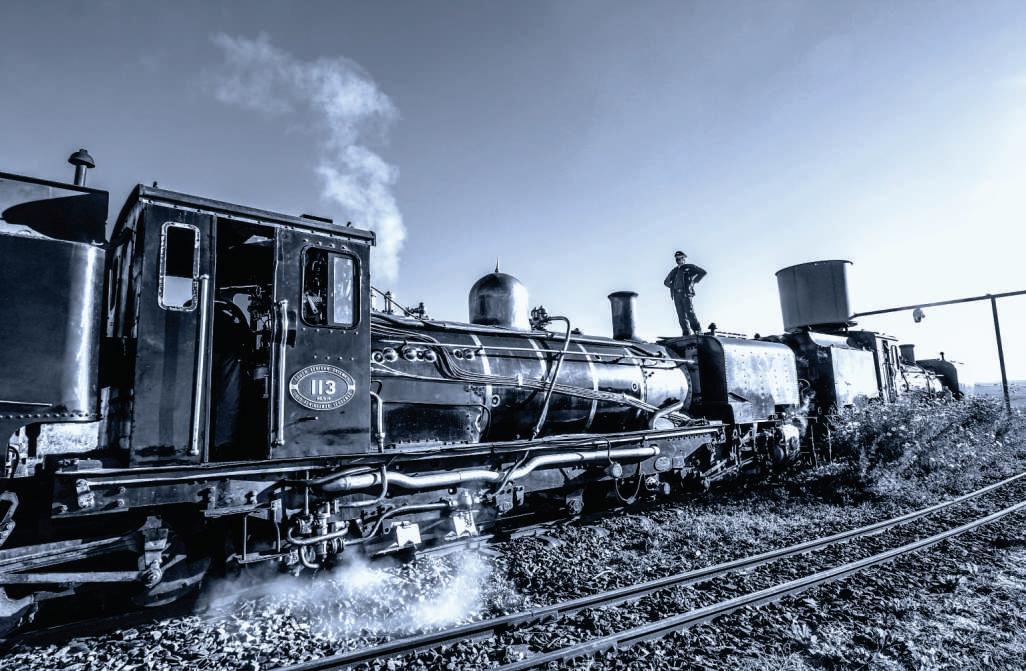
On the Southwest runs, Oom Apie and his stoker would always take a rifle along, rolled up in canvas at the back of the cabin, to shoot “something for the pot”. When they were on a goods trip, it was possible to stop and hunt for a short while.
“One time, Koot Blaauw – the stoker – shot a gemsbok right between the eyes. Between us and the conductor, we tried to load it onto the train.The sun was just going down, and I switched on the train headlights. Here comes this police sergeant and his constable, from nowhere, it seemed to me.
“We told the sergeant we had just run over the buck, and that we didn’t want to see it die a slow death so we slit its throat. He helped us load it, and we butchered it.Then the sergeant took me aside and said:
“’OomApie, if I didn’t know you I’d arrest you. Next time you run over a gemsbok, don’t hit it precisely between the eyes!’
“We gave him a haunch and he left.”
Running Fowl of the Law
Another time, OomApie was working with a certain Gwar Liebenberg on a trip and they shot a guinea fowl for the pot. The bird was duly cleaned and dropped into the fire bucket. When they reached their rest stop at a tiny depot called Usikus, they found a large pot and began cooking the guinea fowl in a stew mix.
“We always travelled with some potatoes and onions, just in case. Anyway, we left the guinea fowl cooking overnight, and the next morning I saw this policeman entering the rest room.”
OomApie told Gwar to prepare the train for their speedy departure. He would rush in and rescue the fowl from the cooking pot before the policeman could catch him.
“But the policeman stayed and sat with me at the table. I couldn’t wait for him to leave.” So the two continues from pg 41 crusties sat there making small talk, eyeing each other
Eventually, the conductor came in to call OomApie, and the desperately hungry driver thought, that’s it! Policeman or no policeman, I’m taking my fowl!
As he rose, so did the anxious policeman.Together they walked to the pot.And each man grabbed his own guinea fowl and left in a separate direction from the other
Breakfast fresh from the furnace
In some circles, it is believed that if the Voortrekker invented the braai, then the train men perfected it.
“We used to take the shovel and load eggs, bacon and sausages onto it.After a short stay in the furnace, the aroma of the best breakfast in the world would filter through the loco. Likewise, coffee brewed in a steam locomotive cannot be beat.”
OomApie Ludwick has some taped memories of the Era of Steam, mostly friends of his who had recorded their experiences for posterity. Playing the tape, you hear those old voices bringing back the past.
“… you came to know the spade. Placing the coals carefully onto the furnace, 12 hours a day You were exhausted, but then that was life. Other stokers would teach you the spade, you would get better with the days.
“Once the steam is in your blood, you cannot keep it out. When a loco beats well, you get chicken bumps on your body The hissing of the steam, the smell of the oil. That whole machine has a life of its own.”
Taking a shine to a loco
And despite the freezing arrivals in DeAar, when snow covered the tracks and cold steel burned the unprotected hand, the winter nights on the Karoo prairie with the wind howling like a banshee and the blistering hot days in the Southwest, the steam experience crept into their souls.
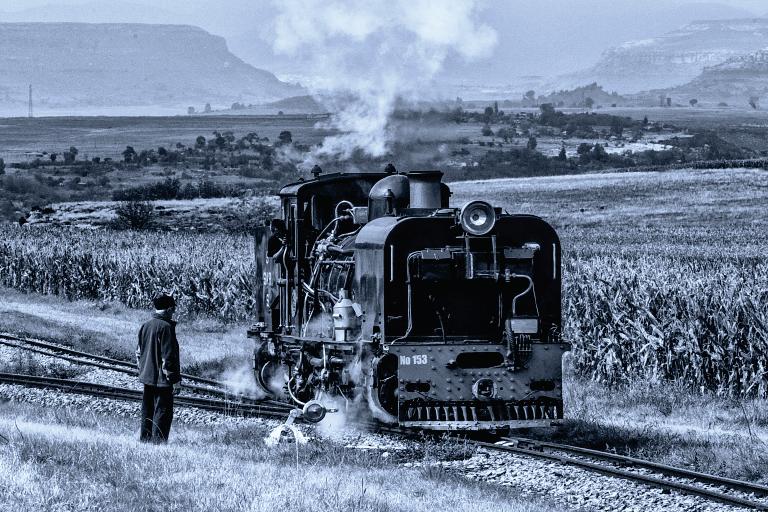
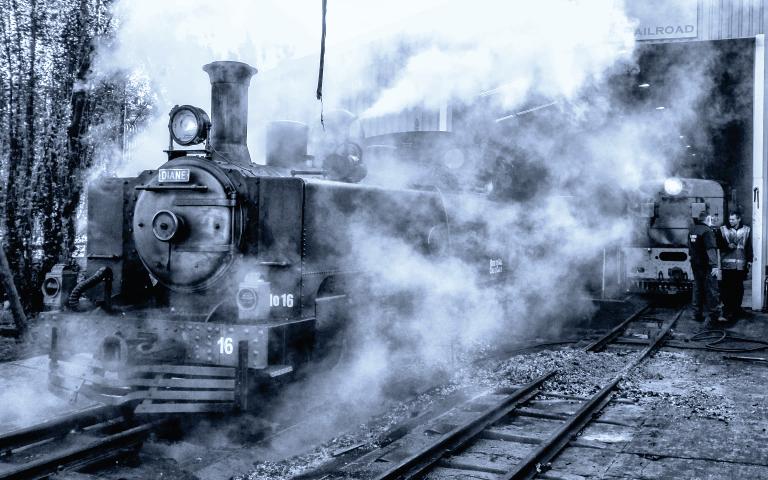
Said OomApie: “Some of the stokers would spend three hours shining up their trains before departure. “At home, you love your wife. On the tracks, the locomotive is your first love.At times, you are more at home in the caboose than out of it.To see that light smoke trail from a Class 25 loco, to hear the sound as it goes uphill with the driver opening up the regulator ever so slightly – that is mother’s milk to a train man.”
Read in Daily Maverick: “Karoo oddities – tales from the quirky, magical heartland of South Africa”
The locomotive graveyard
The steam locos all carry feminine names: Marjorie, Hessie,Anna, Elna, Eliza, Lizette, Ina.They were named after crewmen’s wives and daughters way back then. Piet Claassen has a loco named after his daughter Selma – but it’s also destined for the DeAar steam train graveyard.
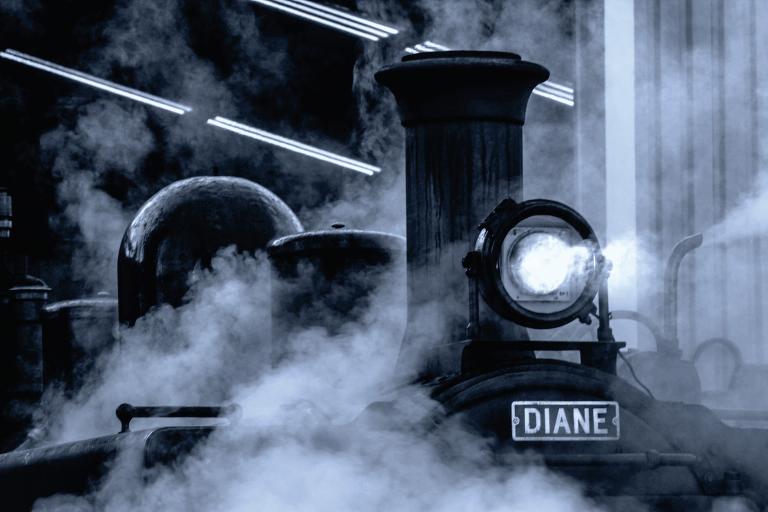
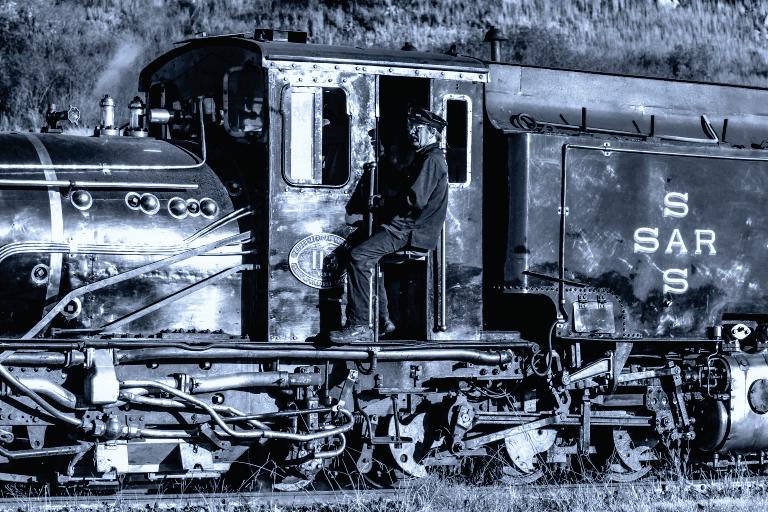
To walk around that graveyard is the poignant experience that still brings thousands of international steam train enthusiasts to DeAar every year The locos are stripped of their name plates, copper pipes and brass fittings.
They stand, stark and bleak, as the wind howls through the empty cabins.The locomotives are lined up end to end, waiting to be purchased and shipped out to the front lawn of some South African small town hall, or simply butchered for scrap by blowtorching.
Nearby, is the rail yard.The best time to be there is at dawn, when soft light reflects off the steamy shanks of the gleaming machines. It’s obviously a sight and sound experience because with a shiny locomotive comes its incessant steam-breathing.
The working locos testify to the pride of their crews.
“We kept them cleaner than our own clothes or our food boxes,” says OomApie. “Even out on a trip, on a slow uphill, we would get out and polish the train. By the time it pulled into a big station, it shone like a jeweller’s shop.” DM/ML










